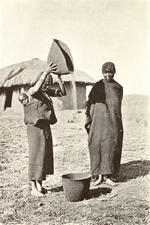
Historically, rural traditionalists produced virtually everything they required to meet their daily needs. The members of individual homesteads grew the grains and other foodstuffs they consumed, planting additional crops to supplement the diets of chickens and other livestock, and foraging for delicacies such as mushrooms, wild African spinach and honey.
The self-sufficiency of these homesteads extended to the manufacture of household items made from grass, like sleeping mats, beer strainers and baskets, and the lids some communities used to cover their beer pots; the preparation of gourds for use as storage containers and ladles; and the carving of small utensils such as spoons.
Other artefacts, notably clay pots and comparatively large vessels, including milk pails and meat platters, were usually made by specialists.
 In KwaZulu-Natal, basket traditions historically associated with men were gradually taken over by women in the course of the twentieth centu...
In KwaZulu-Natal, basket traditions historically associated with men were gradually taken over by women in the course of the twentieth centu... Unlike clay pots and other durable items such as beads and artefacts made from stone or metal, wood seldom survives in archaeological contex...
Unlike clay pots and other durable items such as beads and artefacts made from stone or metal, wood seldom survives in archaeological contex... The production of clay vessels was widespread among South Africa’s Iron Age communities. Associated most obviously with the storage, servi...
The production of clay vessels was widespread among South Africa’s Iron Age communities. Associated most obviously with the storage, servi...